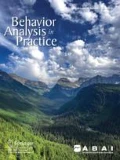Abstract
The present study used a multi-component intervention package to teach on-task rollerblading and ice-skating to a boy with autism. Intervention consisted of response prompts, stimulus prompts, multiple-exemplar training, and a conditioned reinforcement system. The participant learned to remain on-task while rollerblading in a circular route marked by cones for up to 26 min. Both stimulus and response generalization of skating were demonstrated in a variety of non-training settings, including ice-skating at a rink.

Similar content being viewed by others
References
Kaplan-Reimer, H., Sidener, T. M., Reeve, K. F., & Sidener, D. W. (2010). Using stimulus control procedures to teach indoor rock climbing to children with autism. Behavioral Interventions, 26, 1–22. doi:10.1002/bin.315.
Lagomarcino, A., Reid, D., & Ivancic, M. (1984). Leisure dance instruction for severely and profoundly retarded persons: Teaching an intermediate community-living skill. Journal of Applied Behavior Analysis, 17, 71–84. doi:10.1901/jaba.1984.17-71.
LeBlanc, L. A., Hagopian, L. P., Maglieri, K. A., & Poling, A. (2002). Decreasing the intensity of reinforcement-based interventions for reducing behavior: Conceptual issues and a proposed model for clinical practice. The Behavior Analyst Today, 3, 289–300. doi:10.1037/h0099991.
Luyben, P., Funk, D., Morgan, J., Clark, K., & Delulio, D. (1986). Team sports for the severely retarded: Training a side of the foot soccer pass using a maximum-to-minimum prompt reduction strategy. Journal of Applied Behavior Analysis, 19, 431–436. doi:10.1901/jaba.1986.19-431.
McDonnell, J., Johnson, J. W., Polychronis, S., & Risen, T. (2002). Effects of embedded instruction on students with moderate disabilities enrolled in general education classes. Education and Training in Mental Retardation and Developmental Disabilities, 37, 363–377.
O’Conner, Y. M., & Cuvo, A. J. (1989). Teaching dancercise to persons who are mentally handicapped: Programming of transfer of stimulus control to a community setting. Behavioral Residential Treatment, 4, 289–311. doi:10.1002/bin.2360040403.
Rapp, J. T., Vollmer, T. R., & Hovanetz, A. N. (2005). Evaluation and treatment of swimming pool avoidance exhibited by an adolescent girl with autism. Behavior Therapy, 36, 101–105. doi:10.1016/S0005-7894(05)80058-9.
Schleien, S. J., Wehman, P., & Kiernan, J. (1981). Teaching leisure skills to severely. handicapped adults: An age-appropriate darts game. Journal of Applied Behavior Analysis, 14, 513–519. doi:10.1901/jaba.1981.14-513.
Schreibman, L. (1975). Effects of within-stimulus and extra-stimulus prompting on discrimination learning in autistic children. Journal of Applied Behavior Analysis, 8, 91–112. doi:10.1901/jaba.1975.8-91.
Todd, T., & Reid, G. (2006). Increasing physical activity in children with autism. Focus on Autism and Other Developmental Disabilities, 21, 167–176.
Author information
Authors and Affiliations
Corresponding author
Ethics declarations
This research received no direct grants or funding.
Ethical Approval
All procedures performed in studies involving human participants were in accordance with the ethical standards of the institutional and/or national research committee and with the 1964 Helsinki Declaration and its later amendments or comparable ethical standards.
Informed Consent
Informed consent was obtained from all individual participants included in the study.
Conflict of Interest
The authors declare that they have no conflict of interest.
Additional information
An active leisure skill can be taught relatively quickly.
Generalization occurred from rollerblading to ice-skating.
An auditory conditioned reinforcement system can be used without interrupting the learner’s performance.
Stimulus and response prompts can be used and systematically faded together.
Rights and permissions
About this article
Cite this article
Bord, S., Sidener, T.M., Reeve, K.F. et al. Teaching On-Task Rollerblading and Ice-Skating to a Child with Autism. Behav Analysis Practice 10, 178–182 (2017). https://doi.org/10.1007/s40617-016-0150-z
Published:
Issue Date:
DOI: https://doi.org/10.1007/s40617-016-0150-z




